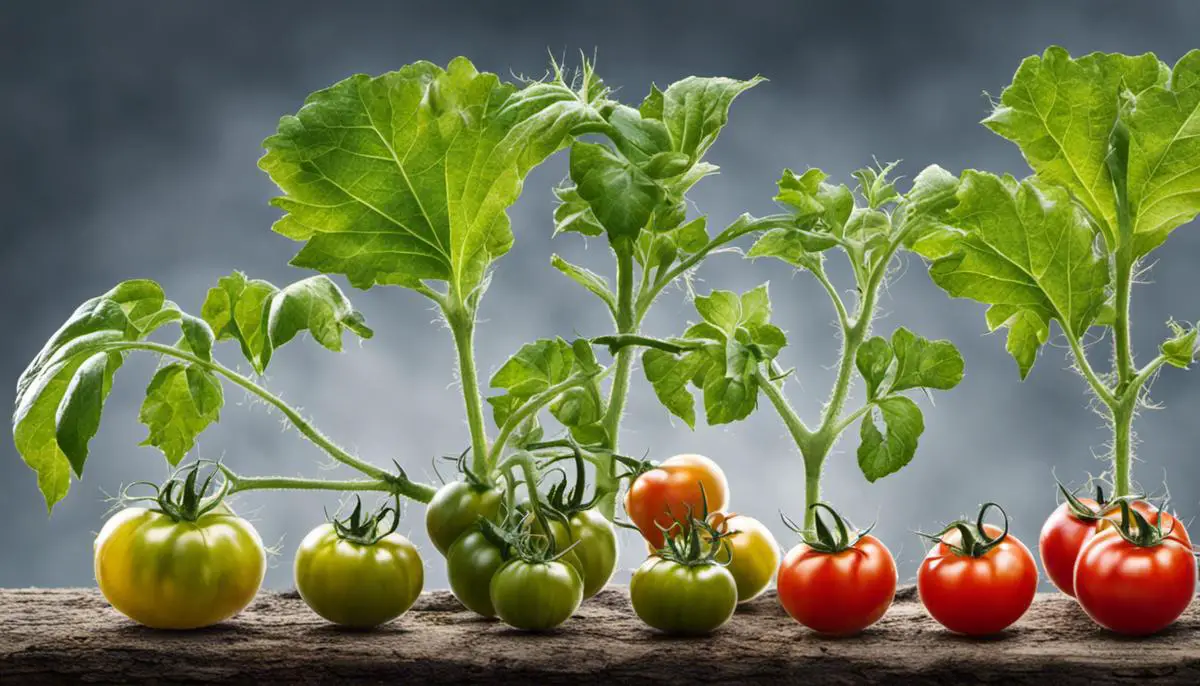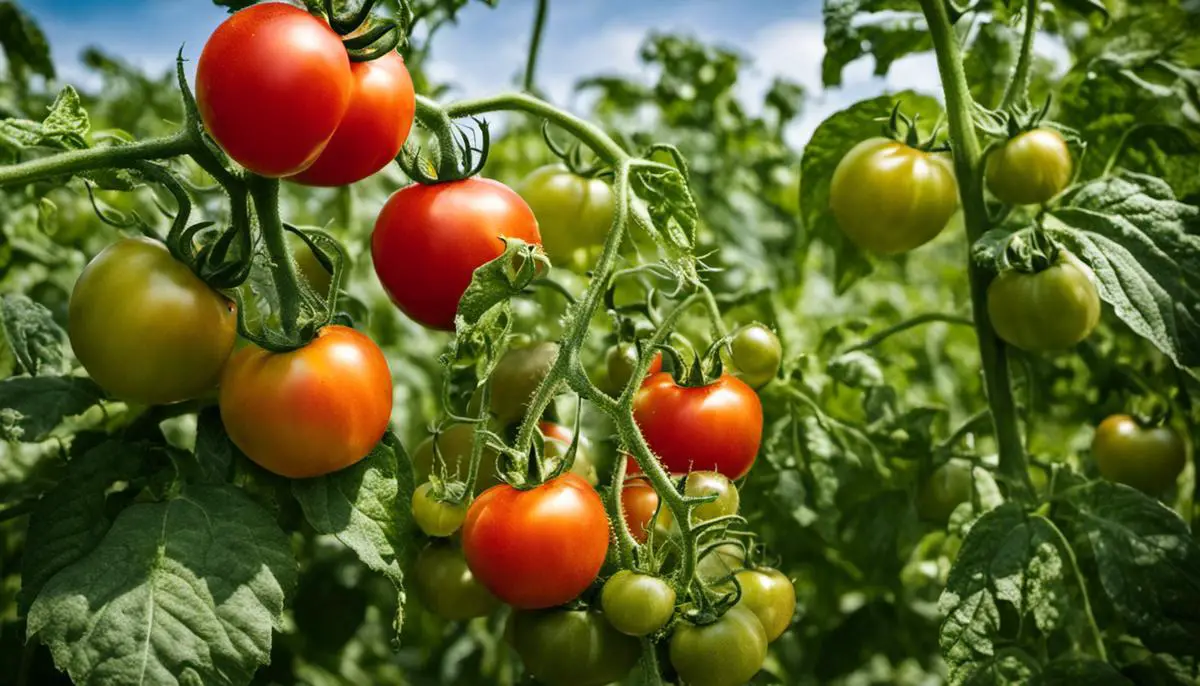The cultivation of tomatoes can often be an exciting enterprise, especially when envisioning the bountiful harvest. However, success hinges on numerous factors, including a farm’s robust defense against diseases that can significantly affect the plant’s development and yield. This broad yet incisive discourse will discuss the most common diseases in tomato plants, their causes and transmission methods, and their palpable effects on tomato yield and quality. More importantly, it provides a well-researched guide on preventing and managing these diseases to ultimately achieve and maintain robust tomato crop health.
Disease Identification and Symptoms
Key Identifiers and Symptoms of Prevalent Tomato Plant Diseases
Reader Poll: What online courses would interest you?
Tomato plants, or Solanum lycopersicum, provide a foundation for comprehensive scientific exploration due to their susceptibility to a wide array of diseases. Being able to identify and recognize the signs and symptoms of these diseases is crucial to their successful cultivation. An informed analysis of the key identifiers and symptoms can aid in the early detection and proper management of these diseases, fostering more robust, productive plants.
Firstly, the Early Blight (Alternaria solani) is a fungus that poses a significant threat to tomato plants. Its presence is denoted by a series of concentric, dark-brown rings on the lower leaves that gradually spread upwards along the stem. The areas within these rings can occasionally exhibit a yellowish color, misleading less experienced observers into mistaking these symptoms for a nutrient deficiency.
Conversely, the Late Blight (Phytophthora infestans) is characterized by large, irregularly shaped, dark spots on the leaves. These spots often exhibit a water-soaked appearance on the leaf surface, progressing eventually to a white, fuzzy growth on the underside of the leaves under humid conditions. This unsightly disease is primarily attributed to cool, moist environments, and can lead to complete plant defoliation if left untreated.
Subscribe to our newsletter!
An equally pertinent disease that fabricates trouble for tomato plants is the Septoria Leaf Spot (Septoria lycopersici). This disease manifests as small black or brown spots on the lower leaves. As the disease progresses, these spots can develop a grayish center surrounded by a dark margin. The leaves eventually turn yellow and wither, falling prematurely from the plant.
One may also encounter a soil-borne disease known as Fusarium and Verticillium Wilt. Though they are caused by different pathogens, Fusarium oxysporum and Verticillium dahliae respectively, the symptoms are quite similar. A yellowing and wilting of the lower leaves is typically observed, progressing slowly upwards. These wilts also exhibit distinct wilting during the heat of the day followed by recovery during cooler temperatures, a phenomenon curiously absent in other diseases.
Lastly, the Tomato Yellow Leaf Curl Virus manifests as an upwards curling of the leaves, giving a stark, cupped appearance. Infected plant growth is stunted and yields significantly less fruit, in sharp contrast to the anticipation attached to the growing season’s potential bounty.
Unquestionably, the impacts of these diseases warrant a diligent prognosis and containment strategy. Recognizing the identifiers and symptoms can ensure early intervention, reducing the potential devastation they can cause. An enlightened understanding of these common tomato plant diseases undoubtedly champions the cause of sustained, healthy cultivation – an endeavor that pays rich dividends in the quest for knowledge and the satisfaction of man’s inherent bond with nature.

Causes and Transmission
Demystifying Diseases: Unveiling Root Causes and Modes of Transmission
When endeavoring to comprehend a disease’s inception and subsequent dispersal in the plant kingdom, knowledge of biological, ecological, and environmental factors is called for. After dissecting the early blight, late blight, Septoria leaf spot, Fusarium and Verticillium wilt, and the tomato yellow leaf curl virus, we now press on to delve into additional disease mechanisms.
Powdery Mildew, for instance, is a widespread plant disease, courtesy of several Ascomycete fungi. The fungi are biotrophic, extracting nutrients from living host tissues while leaving non-invaded tissues unscathed. Wet conditions are unnecessary for their germination; they infiltrate leaf surfaces and produce asexual spores, disseminating the disease via wind or water splashes.
Phytophthora root rot pivots around waterborne oomycete pathogens. These pseudo-fungi utilize zoospores to invade plant roots, particularly in waterlogged soils. Host demise, often rapid, ensues when rot spreads to crowns and stems. Here, limitations in molecular oxygen leading to ATP synthesis reduction plays a part, leading to plant susceptibility to infections.
Fire Blight, caused by the bacterium Erwinia amylovora, is a destructive contagion that primarily impacts Rosaceous plants. The bacteria overwinter within cankers on infected wood, with spring rain and wind disseminating it to flower’s blossoms. Infection is guaranteed when insect vectors or splashing rain transmit these bacteria onto susceptible plant tissues in the flowering stage.
Mosaic Viruses, chief among them Tobacco Mosaic Virus (TMV), exploit mechanical wounds for initial penetration, then capitalize on intracellular trafficking mechanisms to colonize the entire plant. These viruses can survive in plant debris and soil for prolonged periods, facilitating their transmission via contaminated tools, insects, or infected seeds.
The Southern bacterial wilt, caused by Ralstonia solanacearum, is a significant threat to numerous major crops worldwide. The bacterium aggressively invades plant xylem vessels through wounds or natural openings, disrupting water transport and causing the characteristic wilting. The bacteria can persist in soil and plant debris, further promoting disease spread.
Bacterium Xylella fastidiosa, the agent behind citrus variegated chlorosis, transmits primarily through xylem-feeding insects such as sharpshooters. Once introduced, the bacterium colonizes the xylem, disrupting water and nutrient supply. Leaf scorch, shot hole effect, and reduced fruit yield are common symptoms.
Understanding these multifaceted diseases is a step closer to more effective countermeasures. By unraveling the mechanisms and specificities of each contagion, we can tailor preventative strategies, reducing agricultural losses, and bolstering food security in our perpetually growing world. Nevertheless, as research delves deeper, it becomes saliently clear: With every answered question, many more ringing queries beckon for answers. The magnitudes of plant pathogen mysteries yet to unravel are staggering and exciting, encapsulating the curiosity intrinsic to the scientific field.

Impact on Tomato Yield and Quality
Building upon the already laid foundation of understanding how various diseases influence tomato yield and quality, let’s dive into some more specific pathogens and the havoc they wreak on these essential agricultural commodities.
Tomato Spotted Wilt Virus (TSWV) and Bacterial Spot are two such diseases that demand our scrutiny.
TSWV does not discriminate and has one of the widest plant host ranges, infecting over 1,000 different species, tomatoes being one of them. It is a tospovirus transmitted by thrips, tiny insect vectors with rasping-sucking mouthparts. Infected tomato plants display signs like stunted growth, irregular bronzing of leaves, black streaks on stems, and spotted or mottled fruits, significantly impeding the yield and quality. Scrupulous integrated pest management is the most effective control measure, highlighting the need for rigorous scientific inquiry into thrip behavior and TSWV transmission routes.
Bacterial Spot caused by four species of Xanthomonas manifests as small dark spots on leaves, stems, and fruits. As the disease progresses, these spots become necrotic with a yellow halo – a sign of toxin production by the bacteria. The attack of Bacterial Spot not only reduces the overall productivity but also affects the marketability of the fruits due to the aesthetic damage. Xanthomonas species are seedborne and can survive in plant debris; hence, the use of pathogen-free seeds and crop rotation are efficient control strategies.
Then there’s the infamous Blossom End Rot (BER). Rather than a typical disease, BER is a physiological disorder caused by a local calcium deficiency at the blossom end of the fruit. The symptom starts as a small water-soaked spot that gradually enlarges and darkens, leading to a substantial loss in the fruits’ marketable quality. BER is less about the infectivity of a pathogen and more about understanding the precise nutrient requirements of a tomato plant, emphasizing the necessity of robust research into plant nutrition and soil science.
Another significant concern is Tomato Pith Necrosis caused by Pseudomonas corrugata and Pseudomonas mediterranea. This disease obstructs the transportation of water and nutrients and leads to wilting, necrotic lesions, and hollow stems – hugely impacting the crop yield. Effective management includes the pruning of affected stems and ensuring good air circulation, pointing towards the importance of cognizance about plant physiology.
In distinctive, none of these diseases can be effectively managed without a profound understanding of their etymology, pathogenesis, host-pathogen interactions, and environmental influences. The dynamic nature of plant diseases, the continuous emergence of new pathogens, and the uncanny ability of existing ones to evolve resistance against control measures keep plant pathologists on their toes. As scientists devoted to discerning these mysteries, the work is daunting, thrilling, and tremendously crucial to global food security. The quest is on, and the challenge is welcomed.

Prevention and Management
As the understanding of tomato diseases continues to broaden, evolving strategies emerge that are foundational to effective tomato disease prevention and management. One cannot overemphasize the role of cultural practices and sanitation in this arena. Prevention remains the best method and is usually attained by practicing good hygiene. Indeed, several diseases of tomato plants can be managed by implementing simple yet disciplined routines.
Implementing crop rotation is a potent strategy. This technique interrupts the life cycles of pathogens by alternating tomato plants with unrelated crops, effectively thwarting diseases that persist in the soil between tomato plantings. The adage “an ounce of prevention is worth a pound of cure” truly fits here. A recommended rotation frequency for tomatoes is between three to four years, which typically avoids a build-up of disease-causing organisms in the soil.
Another fundamental aspect is seed quality. Using certified disease-free seeds reduces the chance of introducing pathogens into the garden or field. Likewise, resisting the temptation to save seeds from a harvest could be prudent. While economically attractive, the strategy does risk carrying over pathogens from one season to the next.
Tomato plants prefer well-drained soil replete with organic matter. Over-watering or poor soil drainage may induce root diseases, leading to weakened plants and increased disease susceptibility. Mulching can aid in improving soil structure, conserving soil moisture, suppressing weeds, and reducing spore splash from soil to leaves.
Often overlooked, adequate plant spacing provides suitable air circulation that allows moisture to evaporate, reducing the chance of diseases. Numerous tomato diseases are fostered by accommodating conditions such as damp leaves and restricted airflow.
Biotic vectors such as insects can transmit viruses or introduce bacteria into plants. Consequently, sound insect management programs can mitigate tomato diseases that have insect vectors.
Additionally, foliar applications of protected copper and other fungicides can provide reasonable control for a variety of bacterial and fungal diseases. This defense layer could be critical to stem losses in disease-prone environments or seasons.
When dealing with resistant strains, genetic resistance can play a pivotal role. In cases where diseases have developed resistance against other controls, it might be the only viable management strategy.
In conclusion, multiple approaches often provide the most effective management of tomato diseases. By integrating cultural practices, sanitation, good quality seeds, suitable watering, adequate plant spacing, sound insect management, and strategic use of available fungicides, chances of copious, disease-free harvests greatly increase. However, it is essential to appreciate that vigilance and adherence to these practices are key to keeping diseases at bay. As newer pathogens arise and existing ones evolve, tomato disease management remains a dynamic discipline demanding continuous study, research, and attention.

The health of tomato plants, and as a consequence the yield and quality of the harvest, can be jeopardized by a plethora of diseases. As underlined in the preceding sections, understanding these pathogens, their origin, and transmission modes offers invaluable knowledge necessary for implementing effective management strategies. Additionally, complete awareness of the economic implications of these diseases is paramount. It’s clear that comprehensive disease prevention and mitigation practices, backed up by empirical research, make a significant difference. In essence, a farmer’s awareness coupled with strategic action not only protects the health of the individual plant, but contributes to the broader, vital goal of global food security.

